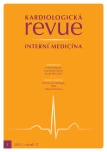Current view on percutaneous treatment of chronic stable coronary artery disease
Authors:
P. Hájek
Authors‘ workplace:
Kardiologická klinika 2. LF UK a FN v Motole, Praha
Published in:
Kardiol Rev Int Med 2015, 17(1): 20-24
Category:
Cardiology Review
Overview
Current results of meta‑analyses and randomized trials have not brought any proof of superiority of PCI or medical therapy in reduction of nonfatal MI or all‑cause or cardiovascular mortality in patients with chronic stable oligosymptomatic coronary artery disease. Therefore, it is necessary to consider several sources of information in the therapeutic decision ‑ making process, such as individual clinical presentation, extent of ischemia or atherosclerosis. The evaluation of individual lesion or patient risk using modern invasive imaging methods and introduction of bioresorbable technologies may play a significant role in this field in the near future. The role of an interventional cardiologist in situations where randomized data are lacking is critical and is based on a responsible choice of appropriate diagnostic and therapeutic strategy considering the best risk/ benefit ratio for the patient.
Keywords:
coronary artery disease – percutaneous coronary intervention
Sources
1. Pijls NH, van Schaardenburgh P, Manoharan G et al. Percutaneous coronary intervention of functionally nonsignificant stenosis: 5‑year follow‑up of the DEFER Study. J Am Coll Cardiol 2007; 49 : 2105 – 2111.
2. Stone GW, Maehara A, Lansky AJ et al. PROSPECT Investigators. A prospective natural ‑ history study of coronary atherosclerosis. N Engl J Med 2011; 364 : 226 – 235. doi: 10.1056/ NEJMoa1002358.
3. Mehta SR, Cannon CP, Fox KA et al. Routine vs selective invasive strategies in patients with acute coronary syndromes: a collaborative meta‑analysis of randomized trials. JAMA 2005; 293 : 2908 – 2917.
4. Hachamovitch R, Hayes SW, Friedman JD et al. Comparison of the short‑term survival benefit associated with revascularization compared with medical therapy in patients with no prior coronary artery disease undergoing stress myocardial perfusion single photon emission computed tomography. Circulation 2003; 107 : 2900 – 2907.
5. Epstein SE, Waksman R, Pichard AD et al. Percutaneous coronary intervention versus medical therapy in stable coronary artery disease: the unresolved conundrum. JACC Cardiovasc Interv 2013; 6 : 993 – 998. doi: 10.1016/ j.jcin.2013.07.003.
6. Boden WE, O'Rourke RA, Teo KK et al. COURAGE Trial Research Group. Optimal medical therapy with or without PCI for stable coronary disease. N Engl J Med 2007; 356 : 1503 – 1516.
7. Shaw LJ, Berman DS, Maron DJ et al. COURAGE Investigators. Optimal medical therapy with or without percutaneous coronary intervention to reduce ischemic burden: results from the Clinical Outcomes Utilizing Revascularization and Aggressive Drug Evaluation (COURAGE) trial nuclear substudy. Circulation 2008; 117 : 1283 – 1291. doi: 10.1161/ CIRCULATIONAHA.107.743963.
8. De Bruyne B, Pijls NH, Kalesan B et al. FAME 2 Trial Investigators. Fractional flow reserve ‑ guided PCI versus medical therapy in stable coronary disease. N Engl J Med 2012; 367 : 991 – 1001. doi: 10.1056/ NEJMoa1205361.
9. Muller JE, Tofler GH, Stone PH. Circadian variation and triggers of onset of acute cardiovascular disease. Circulation 1989; 79 : 733 – 743.
10. Virmani R, Burke AP, Farb A et al. Pathology of the vulnerable plaque. J Am Coll Cardiol 2006; 47 (Suppl 8): C13 – C18.
11. Gardner CM, Tan H, Hull EL et al. Detection of lipid core coronary plaques in autopsy specimens with a novel catheter‑based near ‑ infrared spectroscopy system. JACC Cardiovasc Imaging 2008; 1 : 638 – 648. doi: 10.1016/ j.jcmg.2008.06.001.
12. Waxman S, Dixon SR, L'Allier P et al. In vivo validation of a catheter‑based near ‑ infrared spectroscopy system for detection of lipid core coronary plaques: initial results of the SPECTACL study. JACC Cardiovasc Imaging 2009; 2 : 858 – 868. doi: 10.1016/ j.jcmg.2009.05.001.
13. Serruys PW, Garcia ‑ Garcia HM, Onuma Y. From metallic cages to transient bioresorbable scaffolds: change in paradigm of coronary revascularization in the upcoming decade? Eur Heart J 2012 ; 33 : 16 – 25. doi: 10.1093/ eurheartj/ ehr384.
14. Kang SH, Park KW, Kang DY et al. Biodegradable ‑ polymer drug‑eluting stents vs. bare metal stents vs. durable ‑ polymer drug‑eluting stents: a systematic review and Bayesian approach network meta‑analysis. Eur Heart J 2014; 35 : 1147 – 1158. doi: 10.1093/ eurheartj/ eht570.
15. Serruys PW, Chevalier B, Dudek D et al. A bioresorbable everolimus‑eluting scaffold versus a metallic everolimus‑eluting stent for ischaemic heart disease caused by de ‑ novo native coronary artery lesions (ABSORB II): an interim 1‑year analysis of clinical and procedural secondary outcomes from a randomised controlled trial. Lancet 2015; 385 : 43 – 45. doi: 10.1016/ S0140 ‑ 6736(14)61455 ‑ 0.
Labels
Paediatric cardiology Internal medicine Cardiac surgery CardiologyArticle was published in
Cardiology Review

2015 Issue 1
Most read in this issue
- TDM of digoxin in clinical practice
- Drug interaction and current clinical practice
- Cardiac resynchronization therapy – when should it be indicated and for whom?
- TDM of antibiotics in clinical practice
